Relecould: Configuration Manager and Intune Case Study
VerifiedAdded on 2019/09/22
|21
|4717
|72
Case Study
AI Summary
This case study presents a detailed scenario involving a pharmaceutical company, Relecould, and its IT infrastructure, focusing on the administration of System Center Configuration Manager and Intune. The case study outlines the existing environment, including Active Directory, RDS, and client computer configurations across marketing, research, and development departments. It highlights current problems and planned changes, such as deploying an RDS VDI and managing application virtualization requirements using App-V. The case study poses a series of questions addressing various aspects of Configuration Manager and Intune, including software monitoring, maintenance windows, application supersedence, remote connectivity, client status reporting, collection membership, and software update deployment. The questions require the selection of appropriate actions, commands, or configurations to meet specific requirements, such as ensuring proper reporting, managing device collections, deploying updates from a new vendor, and configuring file associations. The case study also covers Intune-related requirements like deploying internal CA certificates and enabling remote desktop access. The solutions involve understanding and applying Configuration Manager and Intune functionalities to address the challenges and meet the company's evolving needs. The case study also introduces a second scenario involving A.Datum Corporation with two customers and Configuration Manager environments, posing questions about configuration and deployment strategies.
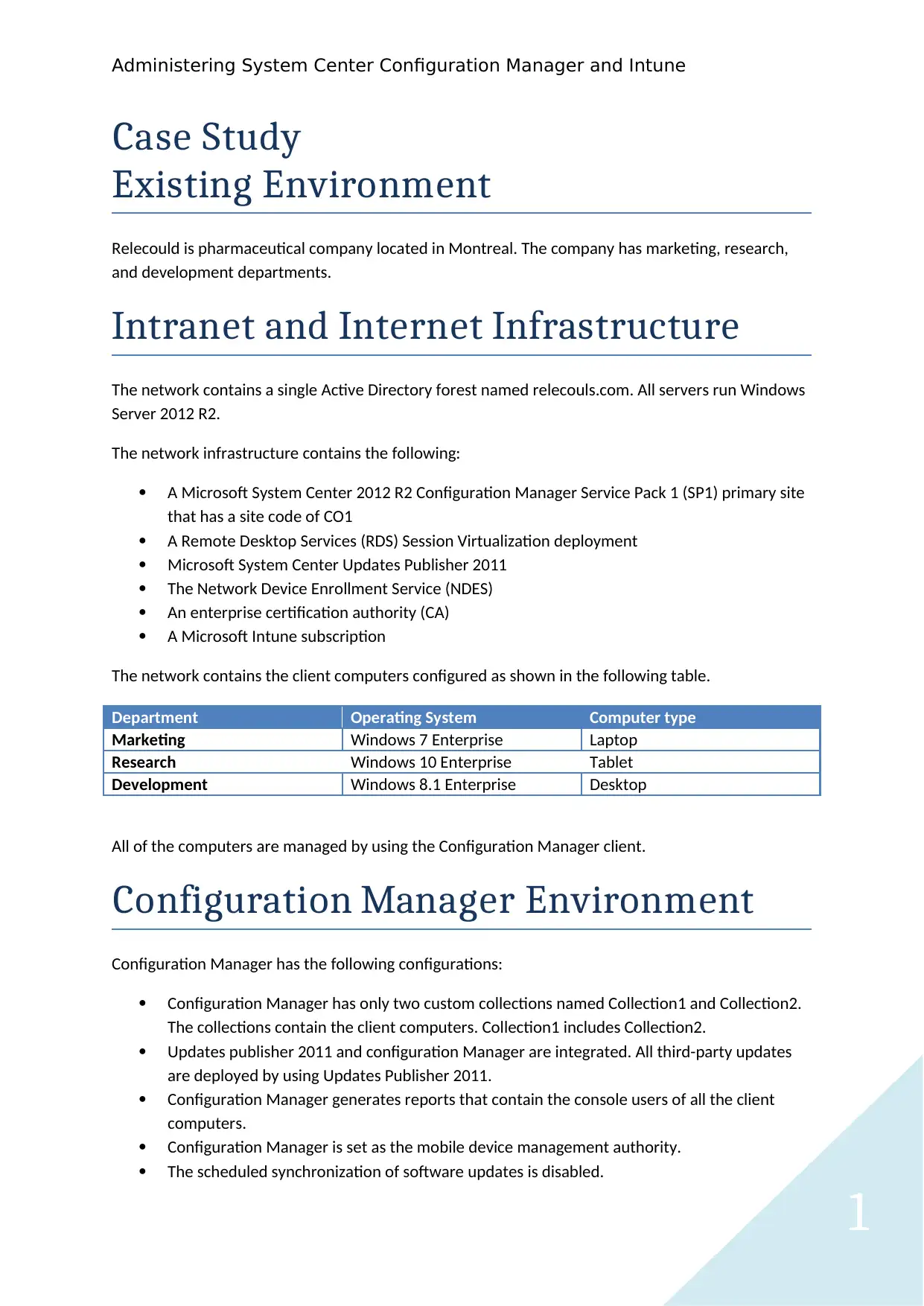
1
Administering System Center Configuration Manager and Intune
Case Study
Existing Environment
Relecould is pharmaceutical company located in Montreal. The company has marketing, research,
and development departments.
Intranet and Internet Infrastructure
The network contains a single Active Directory forest named relecouls.com. All servers run Windows
Server 2012 R2.
The network infrastructure contains the following:
A Microsoft System Center 2012 R2 Configuration Manager Service Pack 1 (SP1) primary site
that has a site code of CO1
A Remote Desktop Services (RDS) Session Virtualization deployment
Microsoft System Center Updates Publisher 2011
The Network Device Enrollment Service (NDES)
An enterprise certification authority (CA)
A Microsoft Intune subscription
The network contains the client computers configured as shown in the following table.
Department Operating System Computer type
Marketing Windows 7 Enterprise Laptop
Research Windows 10 Enterprise Tablet
Development Windows 8.1 Enterprise Desktop
All of the computers are managed by using the Configuration Manager client.
Configuration Manager Environment
Configuration Manager has the following configurations:
Configuration Manager has only two custom collections named Collection1 and Collection2.
The collections contain the client computers. Collection1 includes Collection2.
Updates publisher 2011 and configuration Manager are integrated. All third-party updates
are deployed by using Updates Publisher 2011.
Configuration Manager generates reports that contain the console users of all the client
computers.
Configuration Manager is set as the mobile device management authority.
The scheduled synchronization of software updates is disabled.
Administering System Center Configuration Manager and Intune
Case Study
Existing Environment
Relecould is pharmaceutical company located in Montreal. The company has marketing, research,
and development departments.
Intranet and Internet Infrastructure
The network contains a single Active Directory forest named relecouls.com. All servers run Windows
Server 2012 R2.
The network infrastructure contains the following:
A Microsoft System Center 2012 R2 Configuration Manager Service Pack 1 (SP1) primary site
that has a site code of CO1
A Remote Desktop Services (RDS) Session Virtualization deployment
Microsoft System Center Updates Publisher 2011
The Network Device Enrollment Service (NDES)
An enterprise certification authority (CA)
A Microsoft Intune subscription
The network contains the client computers configured as shown in the following table.
Department Operating System Computer type
Marketing Windows 7 Enterprise Laptop
Research Windows 10 Enterprise Tablet
Development Windows 8.1 Enterprise Desktop
All of the computers are managed by using the Configuration Manager client.
Configuration Manager Environment
Configuration Manager has the following configurations:
Configuration Manager has only two custom collections named Collection1 and Collection2.
The collections contain the client computers. Collection1 includes Collection2.
Updates publisher 2011 and configuration Manager are integrated. All third-party updates
are deployed by using Updates Publisher 2011.
Configuration Manager generates reports that contain the console users of all the client
computers.
Configuration Manager is set as the mobile device management authority.
The scheduled synchronization of software updates is disabled.
Paraphrase This Document
Need a fresh take? Get an instant paraphrase of this document with our AI Paraphraser
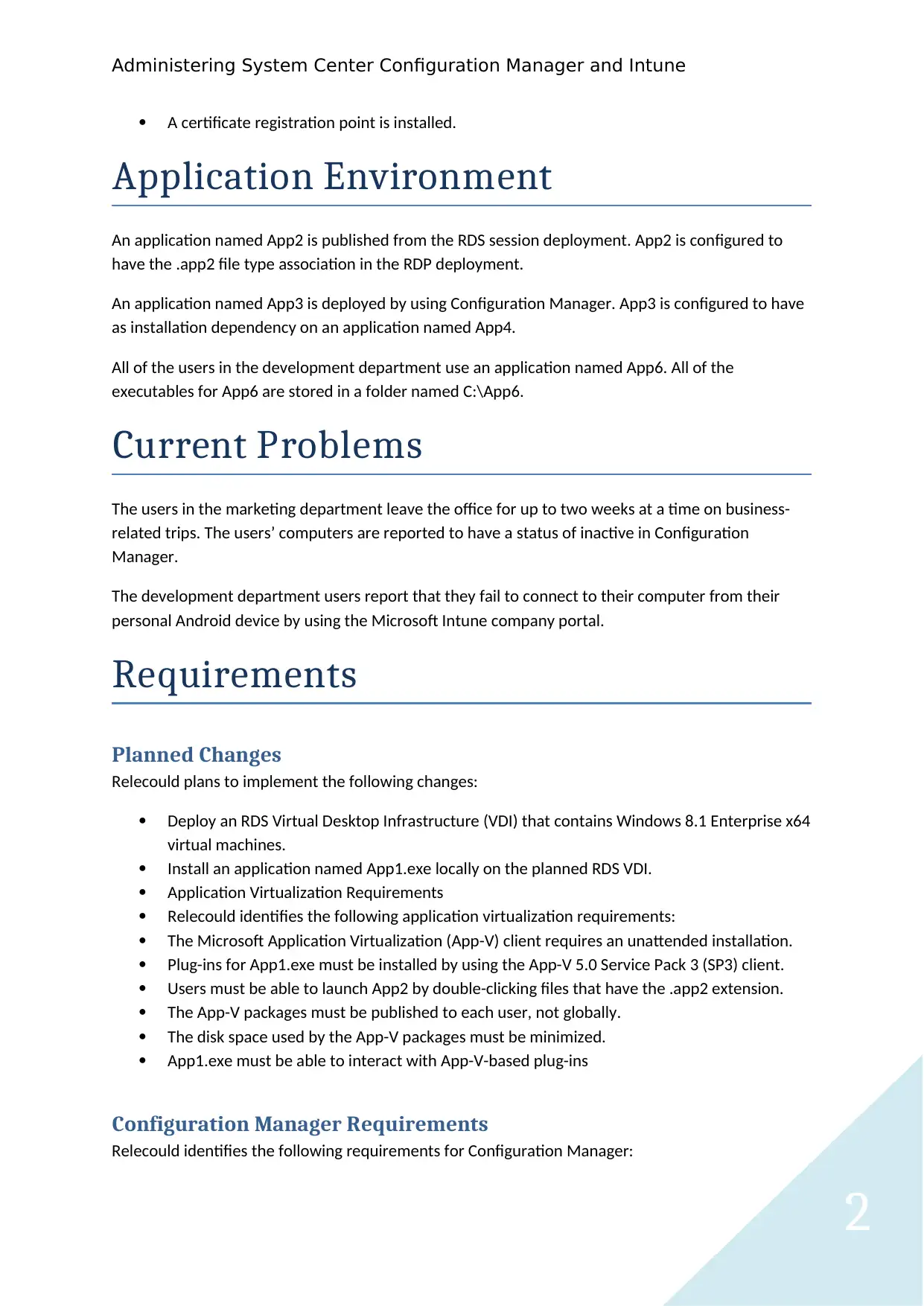
2
Administering System Center Configuration Manager and Intune
A certificate registration point is installed.
Application Environment
An application named App2 is published from the RDS session deployment. App2 is configured to
have the .app2 file type association in the RDP deployment.
An application named App3 is deployed by using Configuration Manager. App3 is configured to have
as installation dependency on an application named App4.
All of the users in the development department use an application named App6. All of the
executables for App6 are stored in a folder named C:\App6.
Current Problems
The users in the marketing department leave the office for up to two weeks at a time on business-
related trips. The users’ computers are reported to have a status of inactive in Configuration
Manager.
The development department users report that they fail to connect to their computer from their
personal Android device by using the Microsoft Intune company portal.
Requirements
Planned Changes
Relecould plans to implement the following changes:
Deploy an RDS Virtual Desktop Infrastructure (VDI) that contains Windows 8.1 Enterprise x64
virtual machines.
Install an application named App1.exe locally on the planned RDS VDI.
Application Virtualization Requirements
Relecould identifies the following application virtualization requirements:
The Microsoft Application Virtualization (App-V) client requires an unattended installation.
Plug-ins for App1.exe must be installed by using the App-V 5.0 Service Pack 3 (SP3) client.
Users must be able to launch App2 by double-clicking files that have the .app2 extension.
The App-V packages must be published to each user, not globally.
The disk space used by the App-V packages must be minimized.
App1.exe must be able to interact with App-V-based plug-ins
Configuration Manager Requirements
Relecould identifies the following requirements for Configuration Manager:
Administering System Center Configuration Manager and Intune
A certificate registration point is installed.
Application Environment
An application named App2 is published from the RDS session deployment. App2 is configured to
have the .app2 file type association in the RDP deployment.
An application named App3 is deployed by using Configuration Manager. App3 is configured to have
as installation dependency on an application named App4.
All of the users in the development department use an application named App6. All of the
executables for App6 are stored in a folder named C:\App6.
Current Problems
The users in the marketing department leave the office for up to two weeks at a time on business-
related trips. The users’ computers are reported to have a status of inactive in Configuration
Manager.
The development department users report that they fail to connect to their computer from their
personal Android device by using the Microsoft Intune company portal.
Requirements
Planned Changes
Relecould plans to implement the following changes:
Deploy an RDS Virtual Desktop Infrastructure (VDI) that contains Windows 8.1 Enterprise x64
virtual machines.
Install an application named App1.exe locally on the planned RDS VDI.
Application Virtualization Requirements
Relecould identifies the following application virtualization requirements:
The Microsoft Application Virtualization (App-V) client requires an unattended installation.
Plug-ins for App1.exe must be installed by using the App-V 5.0 Service Pack 3 (SP3) client.
Users must be able to launch App2 by double-clicking files that have the .app2 extension.
The App-V packages must be published to each user, not globally.
The disk space used by the App-V packages must be minimized.
App1.exe must be able to interact with App-V-based plug-ins
Configuration Manager Requirements
Relecould identifies the following requirements for Configuration Manager:
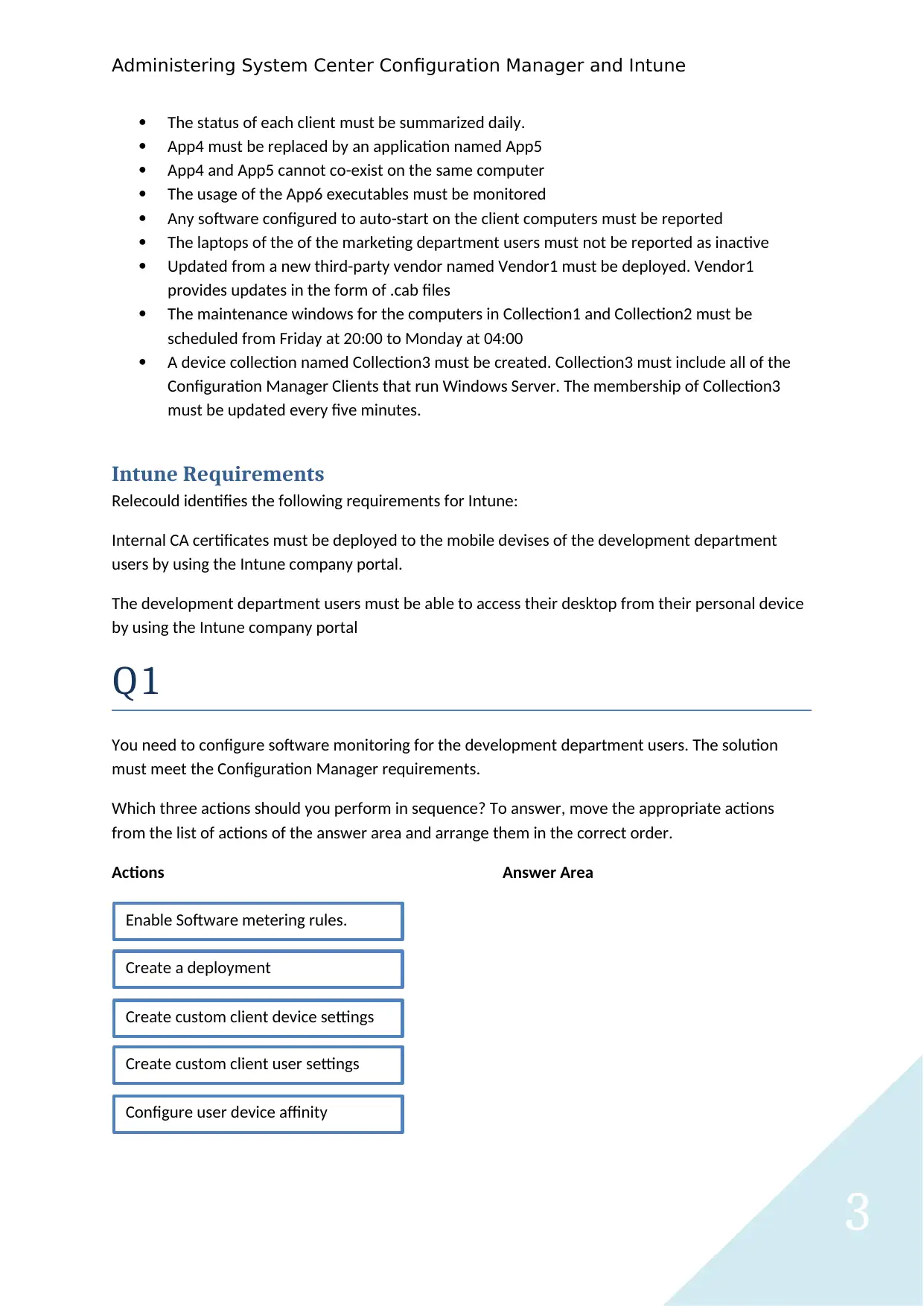
3
Administering System Center Configuration Manager and Intune
The status of each client must be summarized daily.
App4 must be replaced by an application named App5
App4 and App5 cannot co-exist on the same computer
The usage of the App6 executables must be monitored
Any software configured to auto-start on the client computers must be reported
The laptops of the of the marketing department users must not be reported as inactive
Updated from a new third-party vendor named Vendor1 must be deployed. Vendor1
provides updates in the form of .cab files
The maintenance windows for the computers in Collection1 and Collection2 must be
scheduled from Friday at 20:00 to Monday at 04:00
A device collection named Collection3 must be created. Collection3 must include all of the
Configuration Manager Clients that run Windows Server. The membership of Collection3
must be updated every five minutes.
Intune Requirements
Relecould identifies the following requirements for Intune:
Internal CA certificates must be deployed to the mobile devises of the development department
users by using the Intune company portal.
The development department users must be able to access their desktop from their personal device
by using the Intune company portal
Q1
You need to configure software monitoring for the development department users. The solution
must meet the Configuration Manager requirements.
Which three actions should you perform in sequence? To answer, move the appropriate actions
from the list of actions of the answer area and arrange them in the correct order.
Actions Answer Area
Enable Software metering rules.
Create a deployment
Create custom client device settings
Create custom client user settings
Configure user device affinity
Administering System Center Configuration Manager and Intune
The status of each client must be summarized daily.
App4 must be replaced by an application named App5
App4 and App5 cannot co-exist on the same computer
The usage of the App6 executables must be monitored
Any software configured to auto-start on the client computers must be reported
The laptops of the of the marketing department users must not be reported as inactive
Updated from a new third-party vendor named Vendor1 must be deployed. Vendor1
provides updates in the form of .cab files
The maintenance windows for the computers in Collection1 and Collection2 must be
scheduled from Friday at 20:00 to Monday at 04:00
A device collection named Collection3 must be created. Collection3 must include all of the
Configuration Manager Clients that run Windows Server. The membership of Collection3
must be updated every five minutes.
Intune Requirements
Relecould identifies the following requirements for Intune:
Internal CA certificates must be deployed to the mobile devises of the development department
users by using the Intune company portal.
The development department users must be able to access their desktop from their personal device
by using the Intune company portal
Q1
You need to configure software monitoring for the development department users. The solution
must meet the Configuration Manager requirements.
Which three actions should you perform in sequence? To answer, move the appropriate actions
from the list of actions of the answer area and arrange them in the correct order.
Actions Answer Area
Enable Software metering rules.
Create a deployment
Create custom client device settings
Create custom client user settings
Configure user device affinity
⊘ This is a preview!⊘
Do you want full access?
Subscribe today to unlock all pages.

Trusted by 1+ million students worldwide
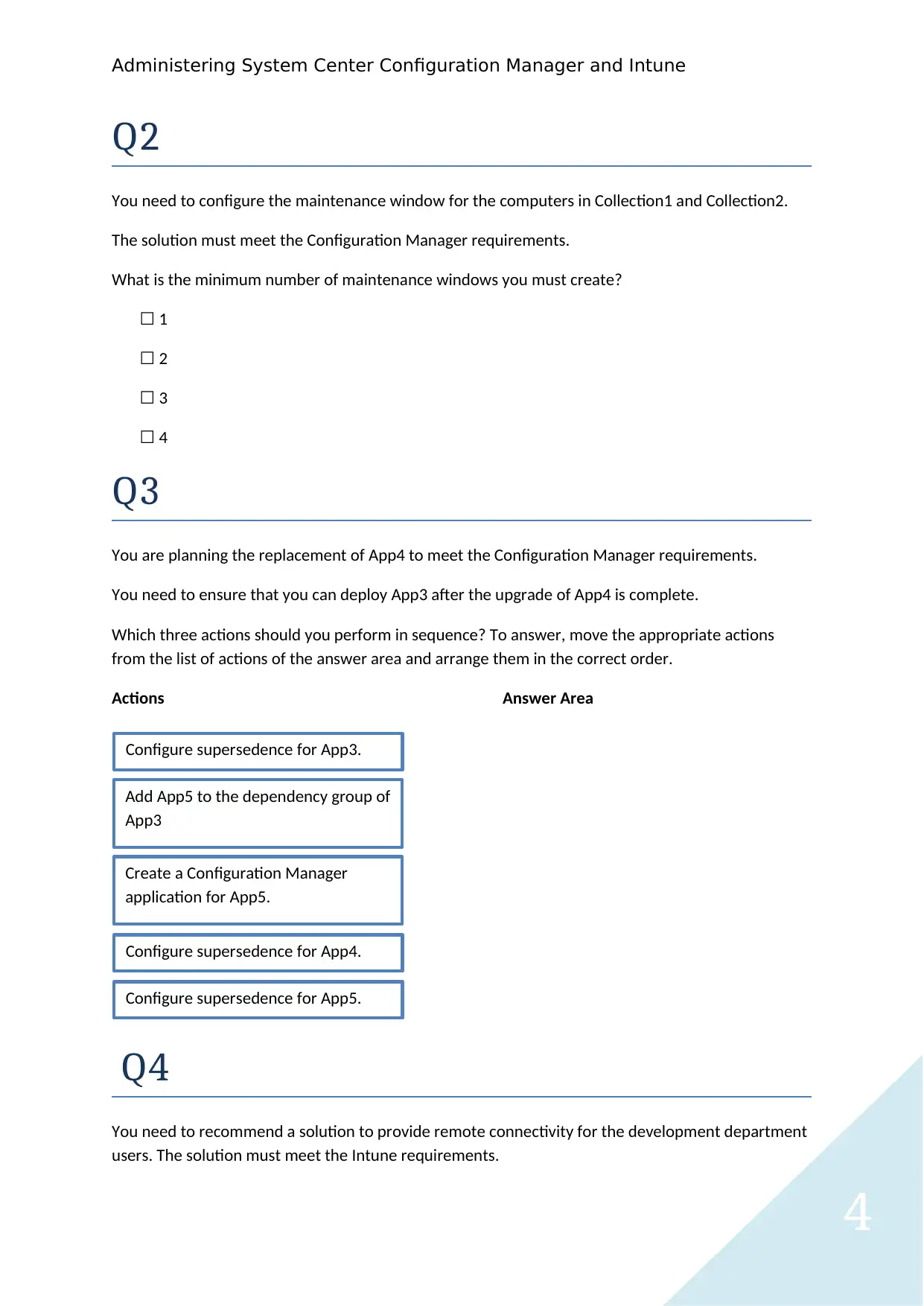
4
Administering System Center Configuration Manager and Intune
Q2
You need to configure the maintenance window for the computers in Collection1 and Collection2.
The solution must meet the Configuration Manager requirements.
What is the minimum number of maintenance windows you must create?
☐ 1
☐ 2
☐ 3
☐ 4
Q3
You are planning the replacement of App4 to meet the Configuration Manager requirements.
You need to ensure that you can deploy App3 after the upgrade of App4 is complete.
Which three actions should you perform in sequence? To answer, move the appropriate actions
from the list of actions of the answer area and arrange them in the correct order.
Actions Answer Area
Q4
You need to recommend a solution to provide remote connectivity for the development department
users. The solution must meet the Intune requirements.
Configure supersedence for App3.
Add App5 to the dependency group of
App3
Create a Configuration Manager
application for App5.
Configure supersedence for App4.
Configure supersedence for App5.
Administering System Center Configuration Manager and Intune
Q2
You need to configure the maintenance window for the computers in Collection1 and Collection2.
The solution must meet the Configuration Manager requirements.
What is the minimum number of maintenance windows you must create?
☐ 1
☐ 2
☐ 3
☐ 4
Q3
You are planning the replacement of App4 to meet the Configuration Manager requirements.
You need to ensure that you can deploy App3 after the upgrade of App4 is complete.
Which three actions should you perform in sequence? To answer, move the appropriate actions
from the list of actions of the answer area and arrange them in the correct order.
Actions Answer Area
Q4
You need to recommend a solution to provide remote connectivity for the development department
users. The solution must meet the Intune requirements.
Configure supersedence for App3.
Add App5 to the dependency group of
App3
Create a Configuration Manager
application for App5.
Configure supersedence for App4.
Configure supersedence for App5.
Paraphrase This Document
Need a fresh take? Get an instant paraphrase of this document with our AI Paraphraser
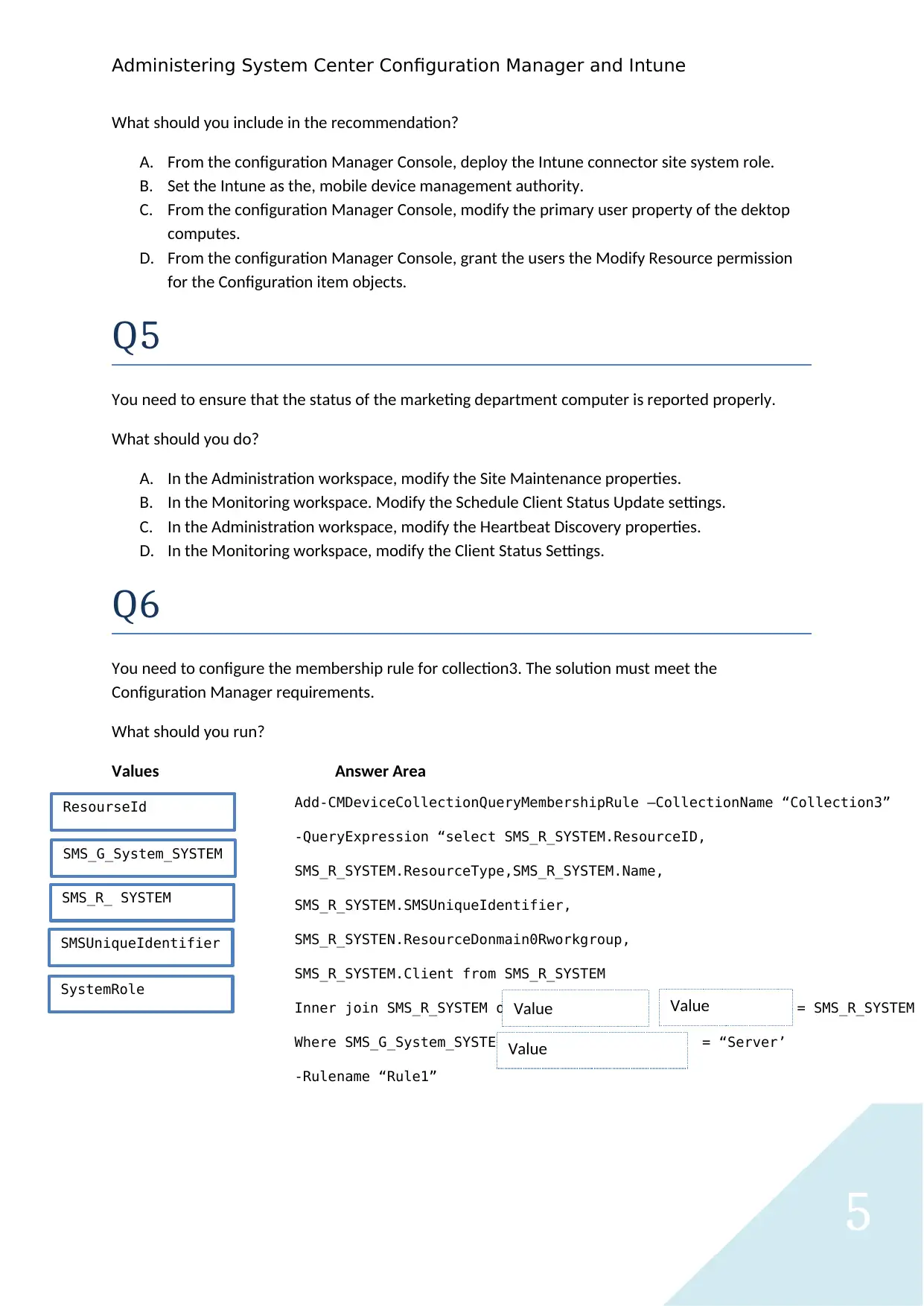
5
Administering System Center Configuration Manager and Intune
What should you include in the recommendation?
A. From the configuration Manager Console, deploy the Intune connector site system role.
B. Set the Intune as the, mobile device management authority.
C. From the configuration Manager Console, modify the primary user property of the dektop
computes.
D. From the configuration Manager Console, grant the users the Modify Resource permission
for the Configuration item objects.
Q5
You need to ensure that the status of the marketing department computer is reported properly.
What should you do?
A. In the Administration workspace, modify the Site Maintenance properties.
B. In the Monitoring workspace. Modify the Schedule Client Status Update settings.
C. In the Administration workspace, modify the Heartbeat Discovery properties.
D. In the Monitoring workspace, modify the Client Status Settings.
Q6
You need to configure the membership rule for collection3. The solution must meet the
Configuration Manager requirements.
What should you run?
Values Answer Area
ResourseId
SMS_G_System_SYSTEM
SMS_R_ SYSTEM
SMSUniqueIdentifier
SystemRole
Add-CMDeviceCollectionQueryMembershipRule –CollectionName “Collection3”
-QueryExpression “select SMS_R_SYSTEM.ResourceID,
SMS_R_SYSTEM.ResourceType,SMS_R_SYSTEM.Name,
SMS_R_SYSTEM.SMSUniqueIdentifier,
SMS_R_SYSTEN.ResourceDonmain0Rworkgroup,
SMS_R_SYSTEM.Client from SMS_R_SYSTEM
Inner join SMS_R_SYSTEM on = SMS_R_SYSTEM
Where SMS_G_System_SYSTEM = “Server’
-Rulename “Rule1”
Value Value
Value
Administering System Center Configuration Manager and Intune
What should you include in the recommendation?
A. From the configuration Manager Console, deploy the Intune connector site system role.
B. Set the Intune as the, mobile device management authority.
C. From the configuration Manager Console, modify the primary user property of the dektop
computes.
D. From the configuration Manager Console, grant the users the Modify Resource permission
for the Configuration item objects.
Q5
You need to ensure that the status of the marketing department computer is reported properly.
What should you do?
A. In the Administration workspace, modify the Site Maintenance properties.
B. In the Monitoring workspace. Modify the Schedule Client Status Update settings.
C. In the Administration workspace, modify the Heartbeat Discovery properties.
D. In the Monitoring workspace, modify the Client Status Settings.
Q6
You need to configure the membership rule for collection3. The solution must meet the
Configuration Manager requirements.
What should you run?
Values Answer Area
ResourseId
SMS_G_System_SYSTEM
SMS_R_ SYSTEM
SMSUniqueIdentifier
SystemRole
Add-CMDeviceCollectionQueryMembershipRule –CollectionName “Collection3”
-QueryExpression “select SMS_R_SYSTEM.ResourceID,
SMS_R_SYSTEM.ResourceType,SMS_R_SYSTEM.Name,
SMS_R_SYSTEM.SMSUniqueIdentifier,
SMS_R_SYSTEN.ResourceDonmain0Rworkgroup,
SMS_R_SYSTEM.Client from SMS_R_SYSTEM
Inner join SMS_R_SYSTEM on = SMS_R_SYSTEM
Where SMS_G_System_SYSTEM = “Server’
-Rulename “Rule1”
Value Value
Value
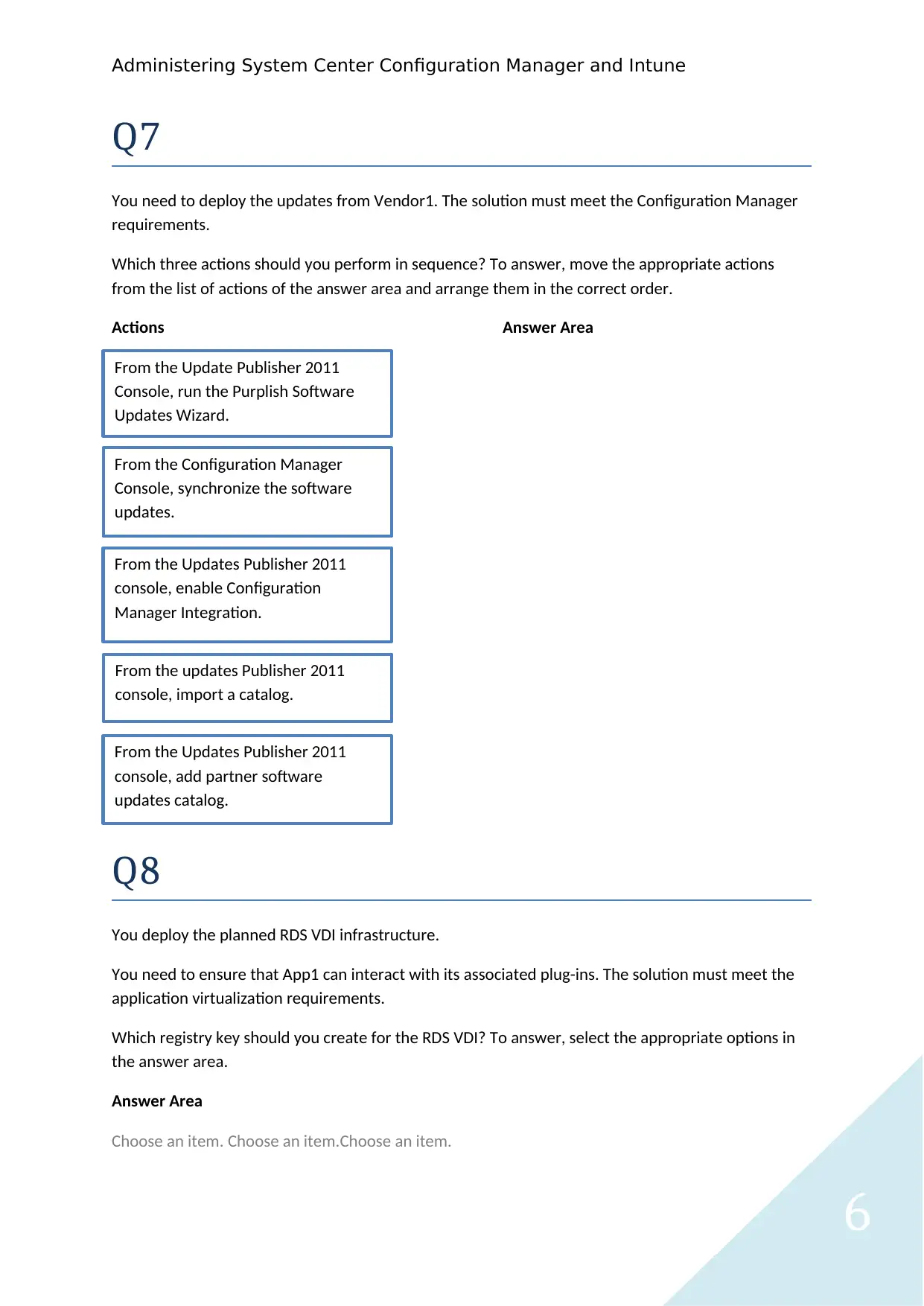
6
Administering System Center Configuration Manager and Intune
Q7
You need to deploy the updates from Vendor1. The solution must meet the Configuration Manager
requirements.
Which three actions should you perform in sequence? To answer, move the appropriate actions
from the list of actions of the answer area and arrange them in the correct order.
Actions Answer Area
.
Q8
You deploy the planned RDS VDI infrastructure.
You need to ensure that App1 can interact with its associated plug-ins. The solution must meet the
application virtualization requirements.
Which registry key should you create for the RDS VDI? To answer, select the appropriate options in
the answer area.
Answer Area
Choose an item. Choose an item.Choose an item.
From the Update Publisher 2011
Console, run the Purplish Software
Updates Wizard.
From the Updates Publisher 2011
console, add partner software
updates catalog.
From the Configuration Manager
Console, synchronize the software
updates.
From the Updates Publisher 2011
console, enable Configuration
Manager Integration.
From the updates Publisher 2011
console, import a catalog.
Administering System Center Configuration Manager and Intune
Q7
You need to deploy the updates from Vendor1. The solution must meet the Configuration Manager
requirements.
Which three actions should you perform in sequence? To answer, move the appropriate actions
from the list of actions of the answer area and arrange them in the correct order.
Actions Answer Area
.
Q8
You deploy the planned RDS VDI infrastructure.
You need to ensure that App1 can interact with its associated plug-ins. The solution must meet the
application virtualization requirements.
Which registry key should you create for the RDS VDI? To answer, select the appropriate options in
the answer area.
Answer Area
Choose an item. Choose an item.Choose an item.
From the Update Publisher 2011
Console, run the Purplish Software
Updates Wizard.
From the Updates Publisher 2011
console, add partner software
updates catalog.
From the Configuration Manager
Console, synchronize the software
updates.
From the Updates Publisher 2011
console, enable Configuration
Manager Integration.
From the updates Publisher 2011
console, import a catalog.
⊘ This is a preview!⊘
Do you want full access?
Subscribe today to unlock all pages.

Trusted by 1+ million students worldwide
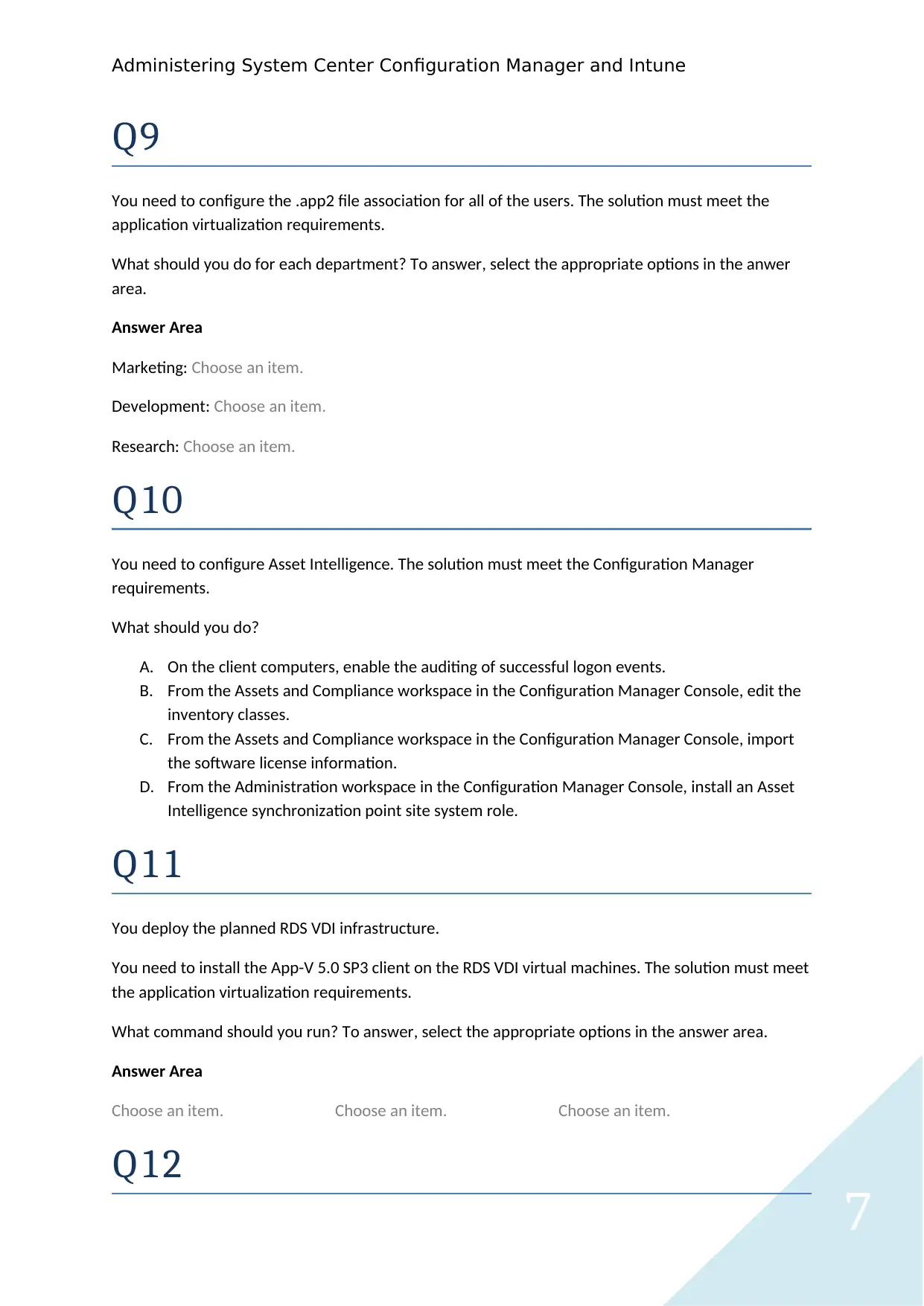
7
Administering System Center Configuration Manager and Intune
Q9
You need to configure the .app2 file association for all of the users. The solution must meet the
application virtualization requirements.
What should you do for each department? To answer, select the appropriate options in the anwer
area.
Answer Area
Marketing: Choose an item.
Development: Choose an item.
Research: Choose an item.
Q10
You need to configure Asset Intelligence. The solution must meet the Configuration Manager
requirements.
What should you do?
A. On the client computers, enable the auditing of successful logon events.
B. From the Assets and Compliance workspace in the Configuration Manager Console, edit the
inventory classes.
C. From the Assets and Compliance workspace in the Configuration Manager Console, import
the software license information.
D. From the Administration workspace in the Configuration Manager Console, install an Asset
Intelligence synchronization point site system role.
Q11
You deploy the planned RDS VDI infrastructure.
You need to install the App-V 5.0 SP3 client on the RDS VDI virtual machines. The solution must meet
the application virtualization requirements.
What command should you run? To answer, select the appropriate options in the answer area.
Answer Area
Choose an item. Choose an item. Choose an item.
Q12
Administering System Center Configuration Manager and Intune
Q9
You need to configure the .app2 file association for all of the users. The solution must meet the
application virtualization requirements.
What should you do for each department? To answer, select the appropriate options in the anwer
area.
Answer Area
Marketing: Choose an item.
Development: Choose an item.
Research: Choose an item.
Q10
You need to configure Asset Intelligence. The solution must meet the Configuration Manager
requirements.
What should you do?
A. On the client computers, enable the auditing of successful logon events.
B. From the Assets and Compliance workspace in the Configuration Manager Console, edit the
inventory classes.
C. From the Assets and Compliance workspace in the Configuration Manager Console, import
the software license information.
D. From the Administration workspace in the Configuration Manager Console, install an Asset
Intelligence synchronization point site system role.
Q11
You deploy the planned RDS VDI infrastructure.
You need to install the App-V 5.0 SP3 client on the RDS VDI virtual machines. The solution must meet
the application virtualization requirements.
What command should you run? To answer, select the appropriate options in the answer area.
Answer Area
Choose an item. Choose an item. Choose an item.
Q12
Paraphrase This Document
Need a fresh take? Get an instant paraphrase of this document with our AI Paraphraser
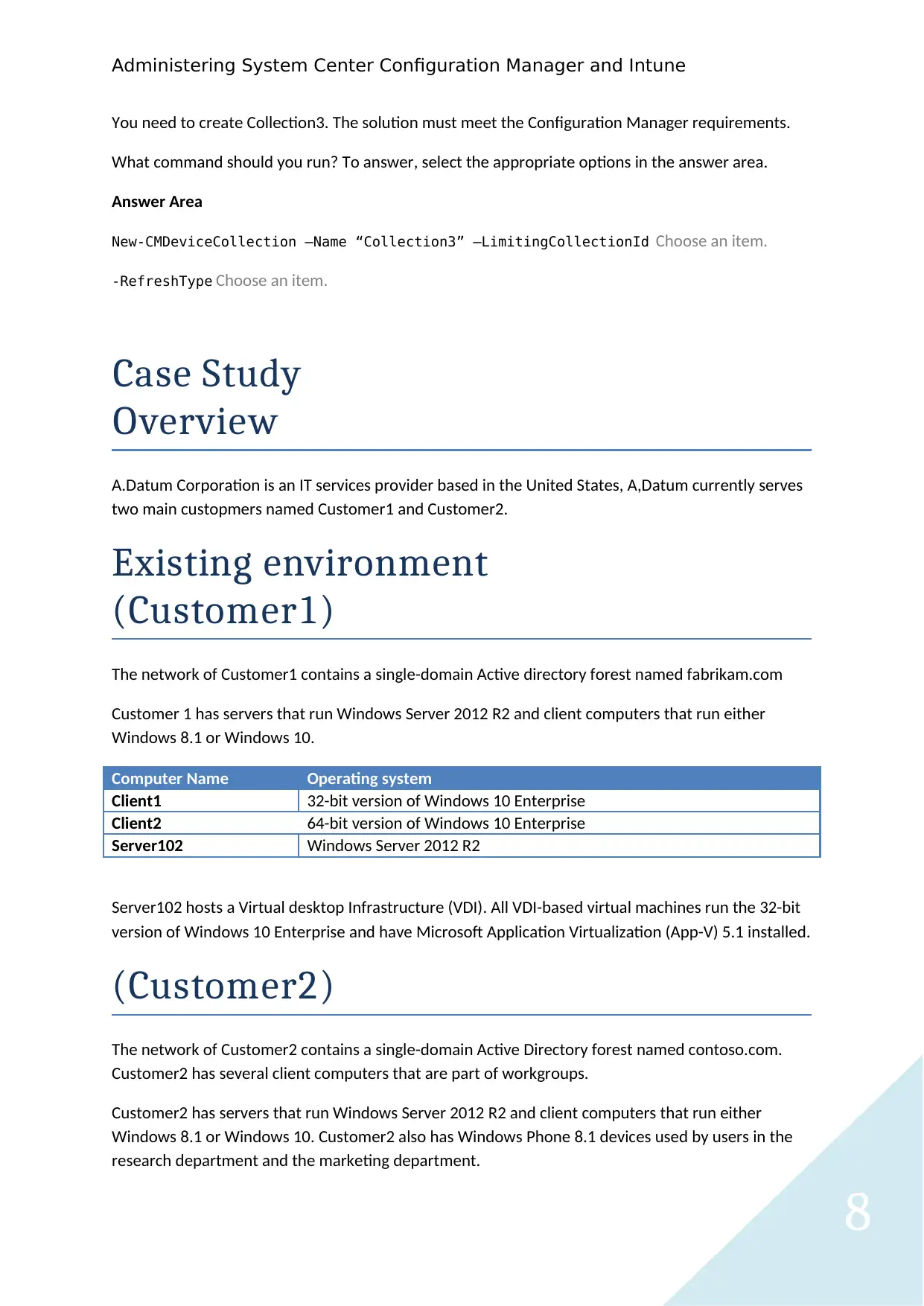
8
Administering System Center Configuration Manager and Intune
You need to create Collection3. The solution must meet the Configuration Manager requirements.
What command should you run? To answer, select the appropriate options in the answer area.
Answer Area
New-CMDeviceCollection –Name “Collection3” –LimitingCollectionId Choose an item.
-RefreshType Choose an item.
Case Study
Overview
A.Datum Corporation is an IT services provider based in the United States, A,Datum currently serves
two main custopmers named Customer1 and Customer2.
Existing environment
(Customer1)
The network of Customer1 contains a single-domain Active directory forest named fabrikam.com
Customer 1 has servers that run Windows Server 2012 R2 and client computers that run either
Windows 8.1 or Windows 10.
Computer Name Operating system
Client1 32-bit version of Windows 10 Enterprise
Client2 64-bit version of Windows 10 Enterprise
Server102 Windows Server 2012 R2
Server102 hosts a Virtual desktop Infrastructure (VDI). All VDI-based virtual machines run the 32-bit
version of Windows 10 Enterprise and have Microsoft Application Virtualization (App-V) 5.1 installed.
(Customer2)
The network of Customer2 contains a single-domain Active Directory forest named contoso.com.
Customer2 has several client computers that are part of workgroups.
Customer2 has servers that run Windows Server 2012 R2 and client computers that run either
Windows 8.1 or Windows 10. Customer2 also has Windows Phone 8.1 devices used by users in the
research department and the marketing department.
Administering System Center Configuration Manager and Intune
You need to create Collection3. The solution must meet the Configuration Manager requirements.
What command should you run? To answer, select the appropriate options in the answer area.
Answer Area
New-CMDeviceCollection –Name “Collection3” –LimitingCollectionId Choose an item.
-RefreshType Choose an item.
Case Study
Overview
A.Datum Corporation is an IT services provider based in the United States, A,Datum currently serves
two main custopmers named Customer1 and Customer2.
Existing environment
(Customer1)
The network of Customer1 contains a single-domain Active directory forest named fabrikam.com
Customer 1 has servers that run Windows Server 2012 R2 and client computers that run either
Windows 8.1 or Windows 10.
Computer Name Operating system
Client1 32-bit version of Windows 10 Enterprise
Client2 64-bit version of Windows 10 Enterprise
Server102 Windows Server 2012 R2
Server102 hosts a Virtual desktop Infrastructure (VDI). All VDI-based virtual machines run the 32-bit
version of Windows 10 Enterprise and have Microsoft Application Virtualization (App-V) 5.1 installed.
(Customer2)
The network of Customer2 contains a single-domain Active Directory forest named contoso.com.
Customer2 has several client computers that are part of workgroups.
Customer2 has servers that run Windows Server 2012 R2 and client computers that run either
Windows 8.1 or Windows 10. Customer2 also has Windows Phone 8.1 devices used by users in the
research department and the marketing department.
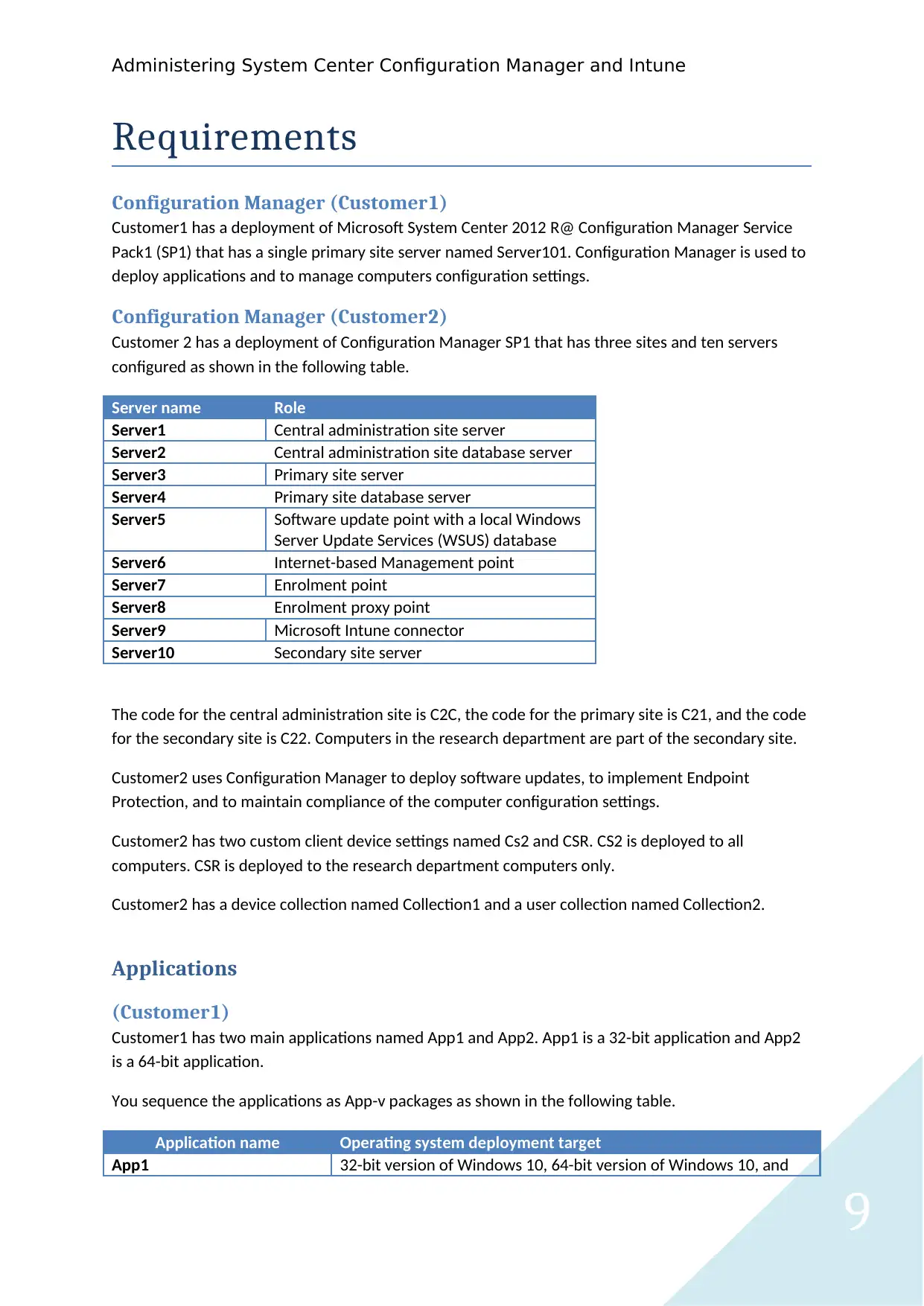
9
Administering System Center Configuration Manager and Intune
Requirements
Configuration Manager (Customer1)
Customer1 has a deployment of Microsoft System Center 2012 R@ Configuration Manager Service
Pack1 (SP1) that has a single primary site server named Server101. Configuration Manager is used to
deploy applications and to manage computers configuration settings.
Configuration Manager (Customer2)
Customer 2 has a deployment of Configuration Manager SP1 that has three sites and ten servers
configured as shown in the following table.
Server name Role
Server1 Central administration site server
Server2 Central administration site database server
Server3 Primary site server
Server4 Primary site database server
Server5 Software update point with a local Windows
Server Update Services (WSUS) database
Server6 Internet-based Management point
Server7 Enrolment point
Server8 Enrolment proxy point
Server9 Microsoft Intune connector
Server10 Secondary site server
The code for the central administration site is C2C, the code for the primary site is C21, and the code
for the secondary site is C22. Computers in the research department are part of the secondary site.
Customer2 uses Configuration Manager to deploy software updates, to implement Endpoint
Protection, and to maintain compliance of the computer configuration settings.
Customer2 has two custom client device settings named Cs2 and CSR. CS2 is deployed to all
computers. CSR is deployed to the research department computers only.
Customer2 has a device collection named Collection1 and a user collection named Collection2.
Applications
(Customer1)
Customer1 has two main applications named App1 and App2. App1 is a 32-bit application and App2
is a 64-bit application.
You sequence the applications as App-v packages as shown in the following table.
Application name Operating system deployment target
App1 32-bit version of Windows 10, 64-bit version of Windows 10, and
Administering System Center Configuration Manager and Intune
Requirements
Configuration Manager (Customer1)
Customer1 has a deployment of Microsoft System Center 2012 R@ Configuration Manager Service
Pack1 (SP1) that has a single primary site server named Server101. Configuration Manager is used to
deploy applications and to manage computers configuration settings.
Configuration Manager (Customer2)
Customer 2 has a deployment of Configuration Manager SP1 that has three sites and ten servers
configured as shown in the following table.
Server name Role
Server1 Central administration site server
Server2 Central administration site database server
Server3 Primary site server
Server4 Primary site database server
Server5 Software update point with a local Windows
Server Update Services (WSUS) database
Server6 Internet-based Management point
Server7 Enrolment point
Server8 Enrolment proxy point
Server9 Microsoft Intune connector
Server10 Secondary site server
The code for the central administration site is C2C, the code for the primary site is C21, and the code
for the secondary site is C22. Computers in the research department are part of the secondary site.
Customer2 uses Configuration Manager to deploy software updates, to implement Endpoint
Protection, and to maintain compliance of the computer configuration settings.
Customer2 has two custom client device settings named Cs2 and CSR. CS2 is deployed to all
computers. CSR is deployed to the research department computers only.
Customer2 has a device collection named Collection1 and a user collection named Collection2.
Applications
(Customer1)
Customer1 has two main applications named App1 and App2. App1 is a 32-bit application and App2
is a 64-bit application.
You sequence the applications as App-v packages as shown in the following table.
Application name Operating system deployment target
App1 32-bit version of Windows 10, 64-bit version of Windows 10, and
⊘ This is a preview!⊘
Do you want full access?
Subscribe today to unlock all pages.

Trusted by 1+ million students worldwide
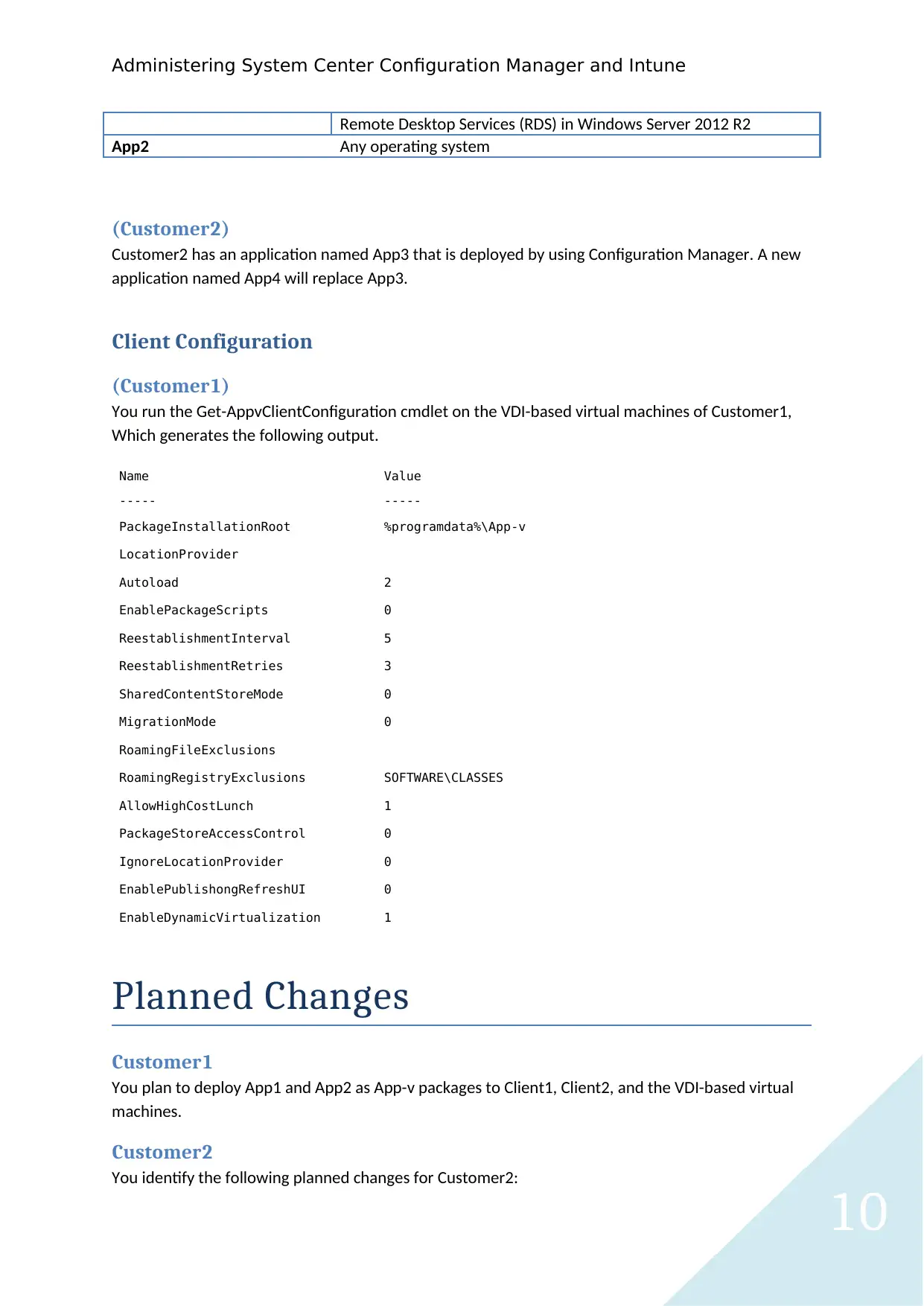
10
Administering System Center Configuration Manager and Intune
Remote Desktop Services (RDS) in Windows Server 2012 R2
App2 Any operating system
(Customer2)
Customer2 has an application named App3 that is deployed by using Configuration Manager. A new
application named App4 will replace App3.
Client Configuration
(Customer1)
You run the Get-AppvClientConfiguration cmdlet on the VDI-based virtual machines of Customer1,
Which generates the following output.
Name Value
----- -----
PackageInstallationRoot %programdata%\App-v
LocationProvider
Autoload 2
EnablePackageScripts 0
ReestablishmentInterval 5
ReestablishmentRetries 3
SharedContentStoreMode 0
MigrationMode 0
RoamingFileExclusions
RoamingRegistryExclusions SOFTWARE\CLASSES
AllowHighCostLunch 1
PackageStoreAccessControl 0
IgnoreLocationProvider 0
EnablePublishongRefreshUI 0
EnableDynamicVirtualization 1
Planned Changes
Customer1
You plan to deploy App1 and App2 as App-v packages to Client1, Client2, and the VDI-based virtual
machines.
Customer2
You identify the following planned changes for Customer2:
Administering System Center Configuration Manager and Intune
Remote Desktop Services (RDS) in Windows Server 2012 R2
App2 Any operating system
(Customer2)
Customer2 has an application named App3 that is deployed by using Configuration Manager. A new
application named App4 will replace App3.
Client Configuration
(Customer1)
You run the Get-AppvClientConfiguration cmdlet on the VDI-based virtual machines of Customer1,
Which generates the following output.
Name Value
----- -----
PackageInstallationRoot %programdata%\App-v
LocationProvider
Autoload 2
EnablePackageScripts 0
ReestablishmentInterval 5
ReestablishmentRetries 3
SharedContentStoreMode 0
MigrationMode 0
RoamingFileExclusions
RoamingRegistryExclusions SOFTWARE\CLASSES
AllowHighCostLunch 1
PackageStoreAccessControl 0
IgnoreLocationProvider 0
EnablePublishongRefreshUI 0
EnableDynamicVirtualization 1
Planned Changes
Customer1
You plan to deploy App1 and App2 as App-v packages to Client1, Client2, and the VDI-based virtual
machines.
Customer2
You identify the following planned changes for Customer2:
Paraphrase This Document
Need a fresh take? Get an instant paraphrase of this document with our AI Paraphraser
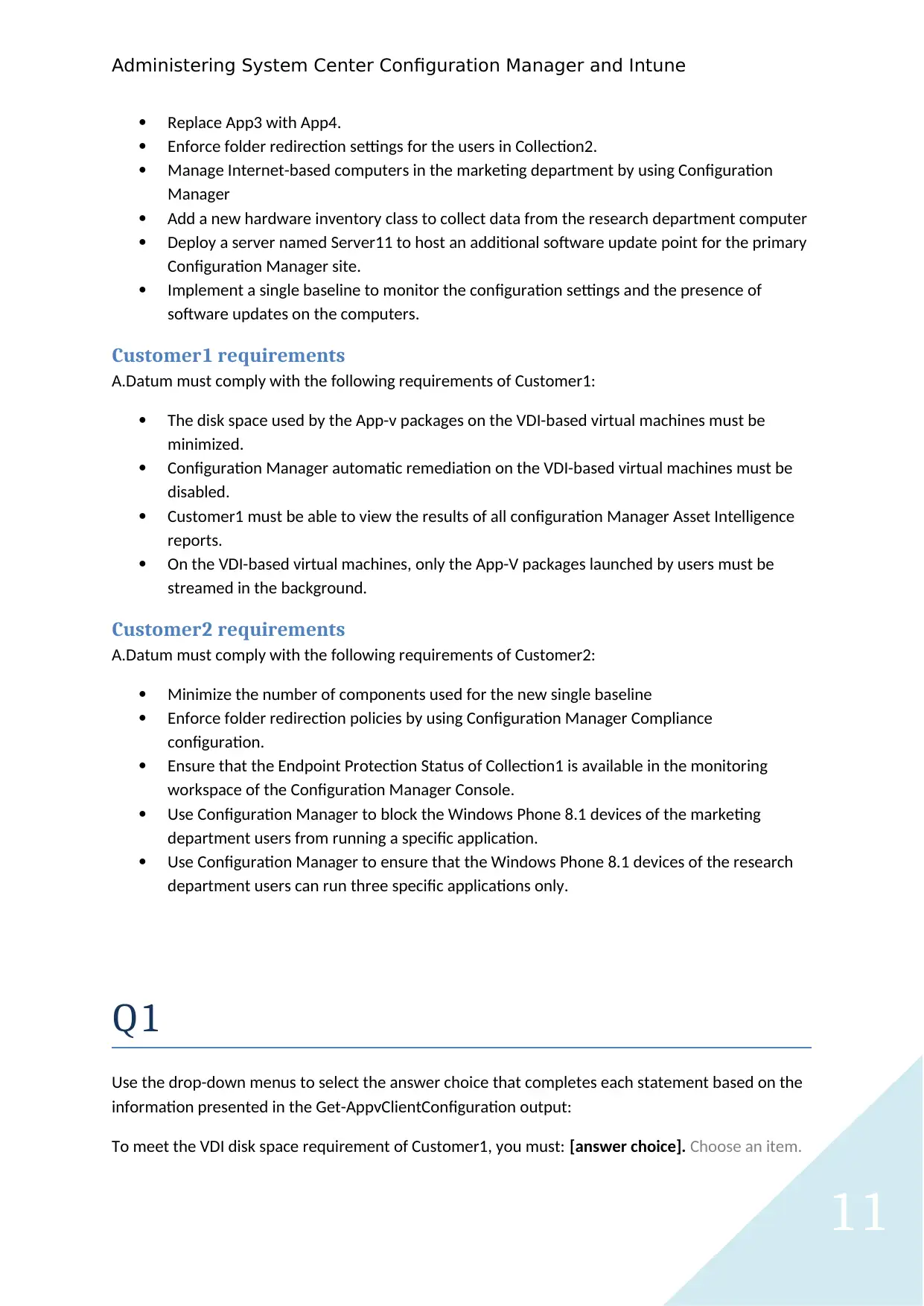
11
Administering System Center Configuration Manager and Intune
Replace App3 with App4.
Enforce folder redirection settings for the users in Collection2.
Manage Internet-based computers in the marketing department by using Configuration
Manager
Add a new hardware inventory class to collect data from the research department computer
Deploy a server named Server11 to host an additional software update point for the primary
Configuration Manager site.
Implement a single baseline to monitor the configuration settings and the presence of
software updates on the computers.
Customer1 requirements
A.Datum must comply with the following requirements of Customer1:
The disk space used by the App-v packages on the VDI-based virtual machines must be
minimized.
Configuration Manager automatic remediation on the VDI-based virtual machines must be
disabled.
Customer1 must be able to view the results of all configuration Manager Asset Intelligence
reports.
On the VDI-based virtual machines, only the App-V packages launched by users must be
streamed in the background.
Customer2 requirements
A.Datum must comply with the following requirements of Customer2:
Minimize the number of components used for the new single baseline
Enforce folder redirection policies by using Configuration Manager Compliance
configuration.
Ensure that the Endpoint Protection Status of Collection1 is available in the monitoring
workspace of the Configuration Manager Console.
Use Configuration Manager to block the Windows Phone 8.1 devices of the marketing
department users from running a specific application.
Use Configuration Manager to ensure that the Windows Phone 8.1 devices of the research
department users can run three specific applications only.
Q1
Use the drop-down menus to select the answer choice that completes each statement based on the
information presented in the Get-AppvClientConfiguration output:
To meet the VDI disk space requirement of Customer1, you must: [answer choice]. Choose an item.
Administering System Center Configuration Manager and Intune
Replace App3 with App4.
Enforce folder redirection settings for the users in Collection2.
Manage Internet-based computers in the marketing department by using Configuration
Manager
Add a new hardware inventory class to collect data from the research department computer
Deploy a server named Server11 to host an additional software update point for the primary
Configuration Manager site.
Implement a single baseline to monitor the configuration settings and the presence of
software updates on the computers.
Customer1 requirements
A.Datum must comply with the following requirements of Customer1:
The disk space used by the App-v packages on the VDI-based virtual machines must be
minimized.
Configuration Manager automatic remediation on the VDI-based virtual machines must be
disabled.
Customer1 must be able to view the results of all configuration Manager Asset Intelligence
reports.
On the VDI-based virtual machines, only the App-V packages launched by users must be
streamed in the background.
Customer2 requirements
A.Datum must comply with the following requirements of Customer2:
Minimize the number of components used for the new single baseline
Enforce folder redirection policies by using Configuration Manager Compliance
configuration.
Ensure that the Endpoint Protection Status of Collection1 is available in the monitoring
workspace of the Configuration Manager Console.
Use Configuration Manager to block the Windows Phone 8.1 devices of the marketing
department users from running a specific application.
Use Configuration Manager to ensure that the Windows Phone 8.1 devices of the research
department users can run three specific applications only.
Q1
Use the drop-down menus to select the answer choice that completes each statement based on the
information presented in the Get-AppvClientConfiguration output:
To meet the VDI disk space requirement of Customer1, you must: [answer choice]. Choose an item.
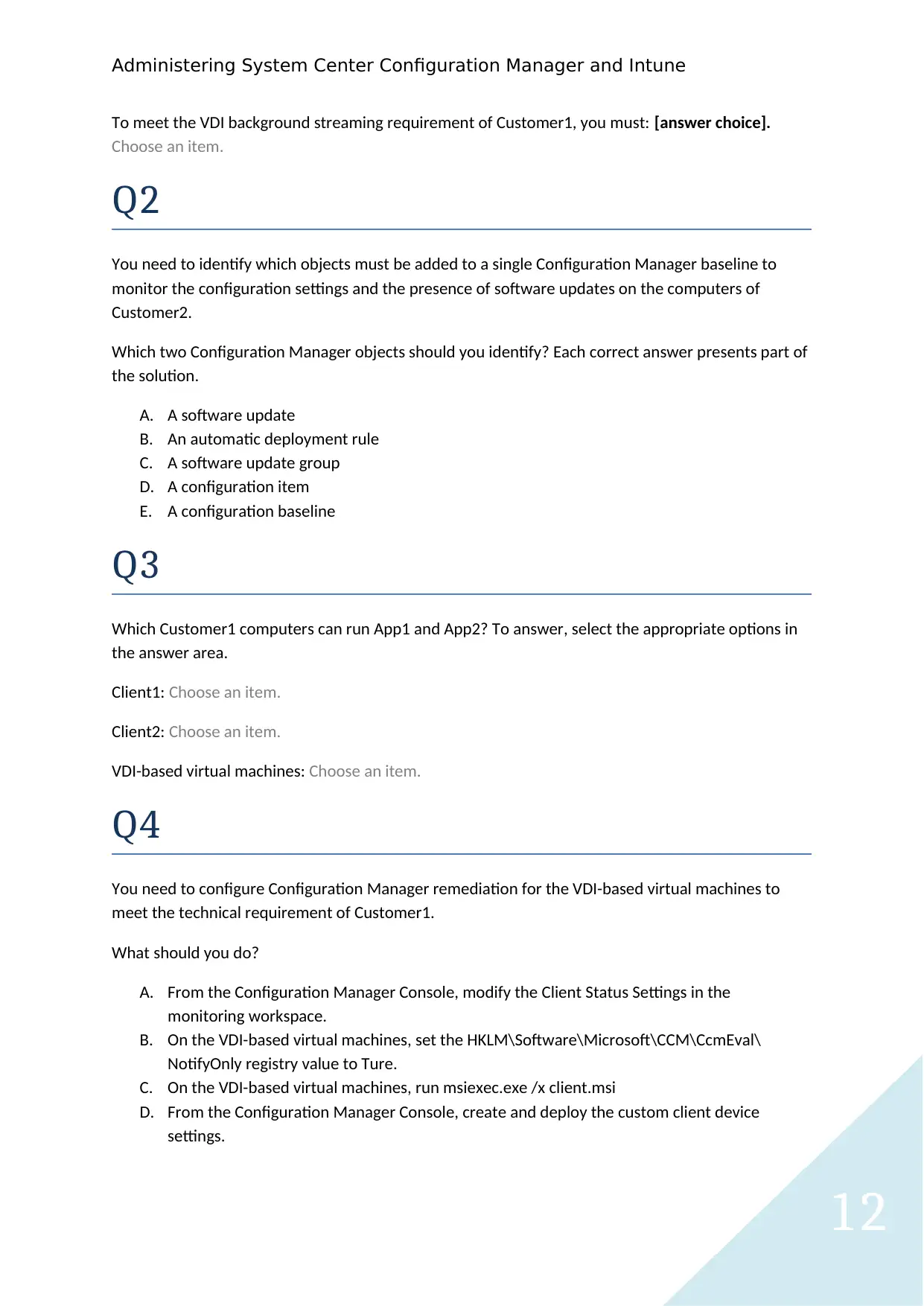
12
Administering System Center Configuration Manager and Intune
To meet the VDI background streaming requirement of Customer1, you must: [answer choice].
Choose an item.
Q2
You need to identify which objects must be added to a single Configuration Manager baseline to
monitor the configuration settings and the presence of software updates on the computers of
Customer2.
Which two Configuration Manager objects should you identify? Each correct answer presents part of
the solution.
A. A software update
B. An automatic deployment rule
C. A software update group
D. A configuration item
E. A configuration baseline
Q3
Which Customer1 computers can run App1 and App2? To answer, select the appropriate options in
the answer area.
Client1: Choose an item.
Client2: Choose an item.
VDI-based virtual machines: Choose an item.
Q4
You need to configure Configuration Manager remediation for the VDI-based virtual machines to
meet the technical requirement of Customer1.
What should you do?
A. From the Configuration Manager Console, modify the Client Status Settings in the
monitoring workspace.
B. On the VDI-based virtual machines, set the HKLM\Software\Microsoft\CCM\CcmEval\
NotifyOnly registry value to Ture.
C. On the VDI-based virtual machines, run msiexec.exe /x client.msi
D. From the Configuration Manager Console, create and deploy the custom client device
settings.
Administering System Center Configuration Manager and Intune
To meet the VDI background streaming requirement of Customer1, you must: [answer choice].
Choose an item.
Q2
You need to identify which objects must be added to a single Configuration Manager baseline to
monitor the configuration settings and the presence of software updates on the computers of
Customer2.
Which two Configuration Manager objects should you identify? Each correct answer presents part of
the solution.
A. A software update
B. An automatic deployment rule
C. A software update group
D. A configuration item
E. A configuration baseline
Q3
Which Customer1 computers can run App1 and App2? To answer, select the appropriate options in
the answer area.
Client1: Choose an item.
Client2: Choose an item.
VDI-based virtual machines: Choose an item.
Q4
You need to configure Configuration Manager remediation for the VDI-based virtual machines to
meet the technical requirement of Customer1.
What should you do?
A. From the Configuration Manager Console, modify the Client Status Settings in the
monitoring workspace.
B. On the VDI-based virtual machines, set the HKLM\Software\Microsoft\CCM\CcmEval\
NotifyOnly registry value to Ture.
C. On the VDI-based virtual machines, run msiexec.exe /x client.msi
D. From the Configuration Manager Console, create and deploy the custom client device
settings.
⊘ This is a preview!⊘
Do you want full access?
Subscribe today to unlock all pages.

Trusted by 1+ million students worldwide
1 out of 21
Related Documents
Your All-in-One AI-Powered Toolkit for Academic Success.
+13062052269
info@desklib.com
Available 24*7 on WhatsApp / Email
![[object Object]](/_next/static/media/star-bottom.7253800d.svg)
Unlock your academic potential
Copyright © 2020–2025 A2Z Services. All Rights Reserved. Developed and managed by ZUCOL.




